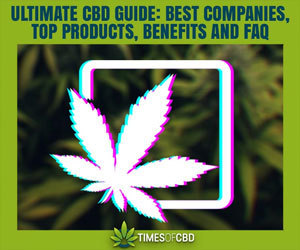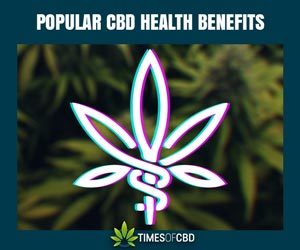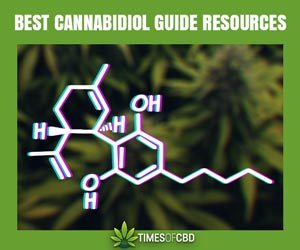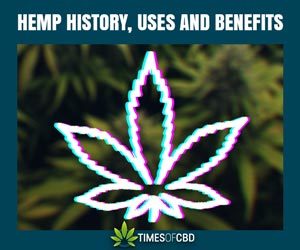CBD News
CBD Oil Certificate of Analysis: How to Analyze CBD CoA Tests
Learn how to read, analyze and understand CBD oil Certificate of Analysis tests to help find the highest-quality cannabis oils and best hemp-derived cannabidiol tinctures that are free of toxic impurities by examining a CoA from independent third-party labs correctly.

How to Read, Analyze, and Understand CBD Oil Certificate of Analysis Tests
Many CBD companies share their certificates of analysis online. Unfortunately, some CBD users don’t know how to read these certificates.
Certificates of analysis look complicated. Some look like lab reports. Others have detailed chemical information that makes no sense to average CBD users. At first glance, it all seems intimidating.
We’re here to help. Today, we’re explaining how to read, analyze, and understand the CBD oil certificate of analysis (CoA) tests.
What is a Certificate of Analysis Test?
A certificate of analysis (CoA) is a document explaining the composition of a product – like a CBD oil or cannabis strain. This document is issued by an accredited laboratory.
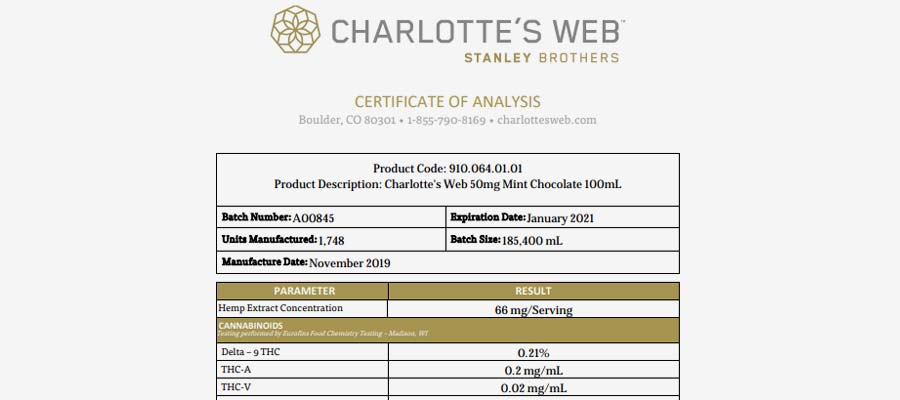
Source: Charlotte’s Web (here)
A CBD certificate of analysis will include a full list of cannabinoids, terpenes, and microbiological levels. It also lists things you don’t want in your product – including contaminants like pesticides, solvent residue, and heavy metals.
All reputable CBD companies publish certificates of analysis online. You might enter the batch number into an online form, for example, to view a certificate for that product. Or, scan the QR code on the label to instantly see that product’s CoA.
Why Are Certificates of Analysis Important?
Certificates of analysis are crucial. Any CBD company can brag about their purity and potency online, but a certificate of analysis tells the real story.
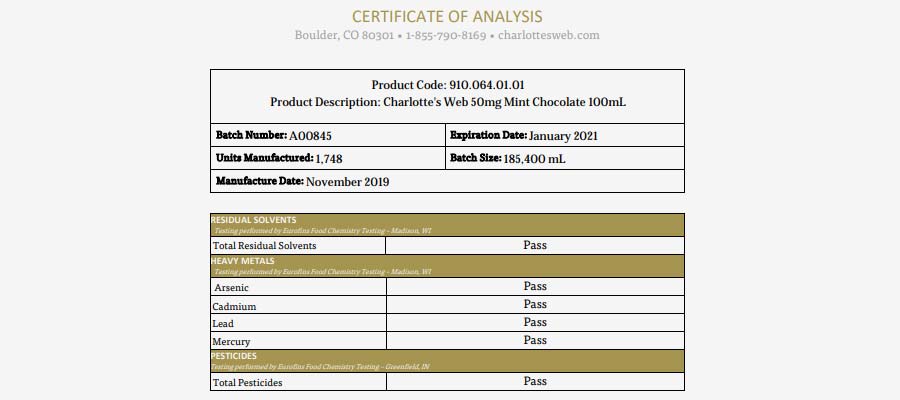
One 2017 study found over 70% of CBD products sold online were mislabeled. Researchers purchased and tested 84 products and found many of them had lower dosages than labeled.
Without certificates of analysis, two CBD products might seem identical – but in reality, they’re vastly different. One CBD product might be loaded with contaminants, pesticides, and heavy metals. Another CBD product might be packed with terpenes and other full-spectrum goodies. Both CBD products are labeled as having 500mg of CBD – but the quality of this CBD varies widely.
With nutritional supplements, certificates of analysis are less critical: yes, an independent lab can verify nutritional information and potency. But dietary supplements have detailed labels explaining ingredients and dosages. Anyone can check the label to compare the supplement to something else.
With CBD products, we don’t have a nutritional label. Even if we did, it wouldn’t display useful information. It might tell us the ingredients (CBD) and the dosage (500mg, for example), but it doesn’t tell us the quality of CBD.
Certificates of analysis are also unbiased. They’re created by reputable, independent, third-party labs. These labs simply test the CBD product they receive – they’re not motivated to sell CBD or advertise a product.
For all of these reasons, it’s crucial to check the CoA before using a CBD product.
Reasons to Check a Certificate of Analysis
There are plenty of good reasons to check a CBD product’s certificate of analysis. Some common causes include:
- Verify a full spectrum CBD product contains terpenes and other cannabinoids
- Check if a CBD product contains the labeled amount of CBD
- Determine if there’s a significant amount of THC in your CBD product (or 0%)
- Verify purity by checking for heavy metals, microbes, and other contaminants
- Ensure a CBD company is transparent with its marketing and labeling
- Separate two CBD products with equal dosages from one another
Some people are careful with CBD due to health reasons. Others want to avoid testing positive for THC on a drug test. There are plenty of good reasons to check a certificate of analysis.
How to Find Certificates of Analysis
Finding certificates of analysis is straightforward. There are several ways to find a CoA:
Check the company’s website or the product page. Many reputable CBD companies share their CoAs upfront, making it easy to compare their products.
Google it. A company might not share their CoA, although you may still be able to find it on Google.
Check with a third party lab. Some labs collect all CoA testing information into a searchable database. You can look up specific companies or products in this database.
Check the QR code. Many CBD products come with a QR code that you can scan to learn more. Just hold your phone camera over the QR code to scan it, then view CoA information directly from your phone. Three states have passed laws requiring QR codes in all CBD products, including Indiana, Texas, Utah, and Florida.
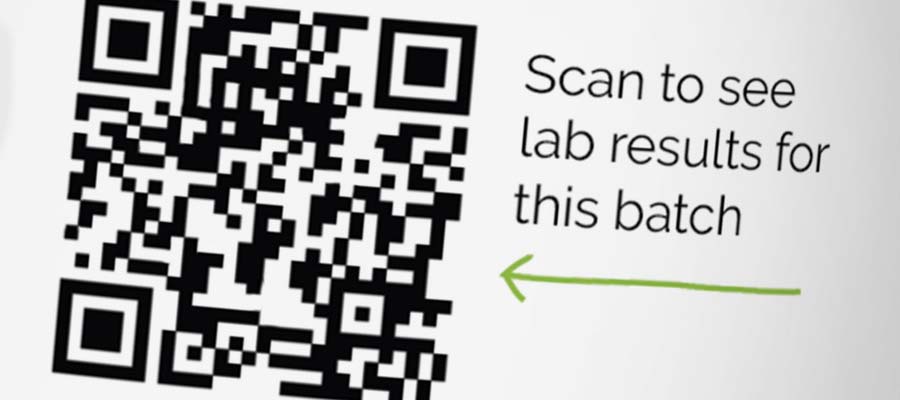
Contact the company. Some companies do not disclose CoAs upfront, although they will reveal the certificate upon request. Contact the company and ask for a CoA.
Using these strategies, you can find detailed lab reports for CBD oil, cannabis plant material, CBD isolates, CBD e-liquids, CBD teas, CBD patches, CBD edibles, hemp seed oil, powder, crystals, and more.
How to Read a Certificate of Analysis
Here’s what a typical certificate of analysis looks like, courtesy of CV Sciences.
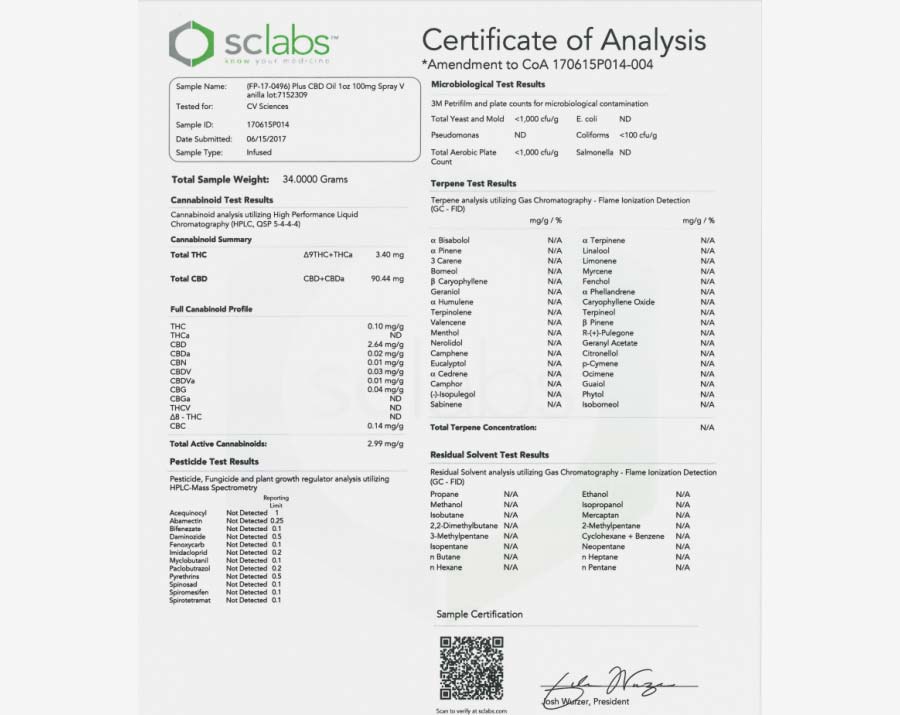
Opening a certificate of analysis can be intimidating. Right away, there’s lots of information to look at. It’s a technical lab report – not a flowery description of a CBD product.
Below, we’ll break down the specific information included in this report, including how anyone can understand and then use this information.
Who Performed the Test?
Most certificates of analysis are performed by reputable, independent labs. These labs are not connected to the CBD manufacturer or actual CBD product in any way.
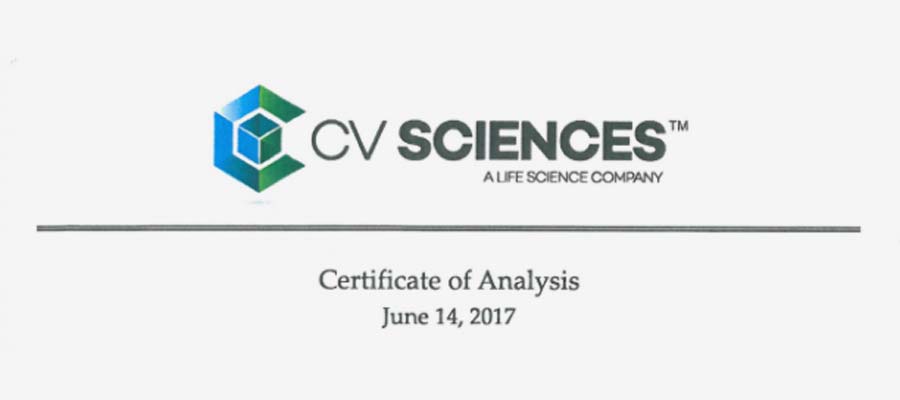
Check the report for the name of the lab. It should be listed near the top.
Only an accredited lab can give precise results for CBD testing. Some certificates of analysis look like they were performed by a qualified, independent lab – when it’s actually a lab connected to the CBD manufacturer.
When an accredited lab tests a CBD product, the lab attaches a certificate ID to the report. You can use this ID to identify the test at a later date.
Some labs have a fancy logo at the top. Others just list their name and contact information. Look for the name of the lab that performed the test. Verify they completed the analysis for the stated company. In the example above, we can see a lab named SC Labs tested a 34g CBD sample from CV Sciences.
Dosage
CBD certificates of analysis report dosage in three ways:
Milligrams (mg) of CBD in the overall product
Milligrams (mg) of CBD per gram of product
Milligrams (mg) of CBD per milliliter of the product

Some certificates of analysis also list the testing method. With the test below, for example, the lab used ‘HPLC,’ or ‘High-Performance Liquid Chromatography’ to verify the presence of cannabinoids. HPLC is a common technique that separates different constituents of a compound using high pressure to push solvents through a column.
Milligrams of CBD Per Gram
Labs use this dosage for dry products, edibles, and other CBD products. You need to know the total weight of a product in grams. The lab does not include the weight of the packaging in the analysis.
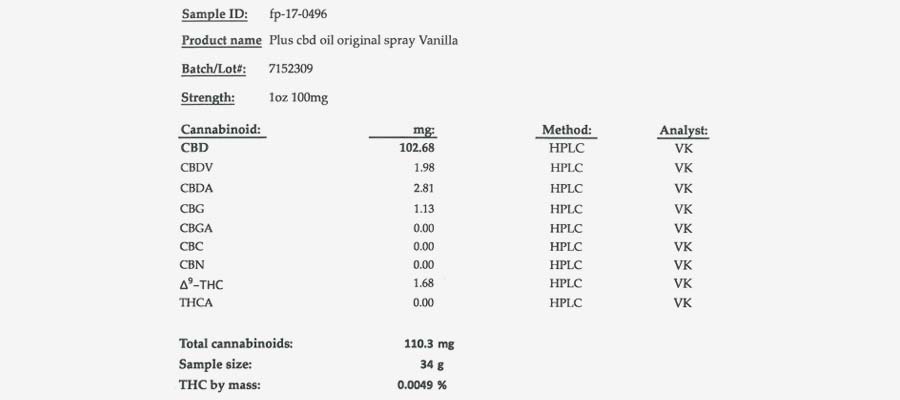
Some CBD products list weight on their packaging, while others do not. You might know a CBD product contains 10mg of CBD per gram, for example, but not the total weight of the CBD product. However, this measurement still gives a good ballpark of how much CBD you should expect.
Milligrams of CBD Per Milliliter
Labs use this dosage when testing CBD oils. It shows the concentration of CBD (in mg) in each unit of liquid (in milliliters). To calculate the amount of CBD in the entire bottle, multiply the dosage by the volume.
If a 30mL bottle of CBD oil contains 10mg of CBD per mL, for example, then the bottle contains 300mg of CBD in total.
For dosage, a standard dropper produces 20 drops per milliliter, although dropper sizes differentiate. Based on the dosage above, you would need to use 20 drops to get 10mg of CBD.
Cannabinoid Content
Dosage information is straightforward. Cannabinoid content is where CBD products differentiate themselves from the competition.
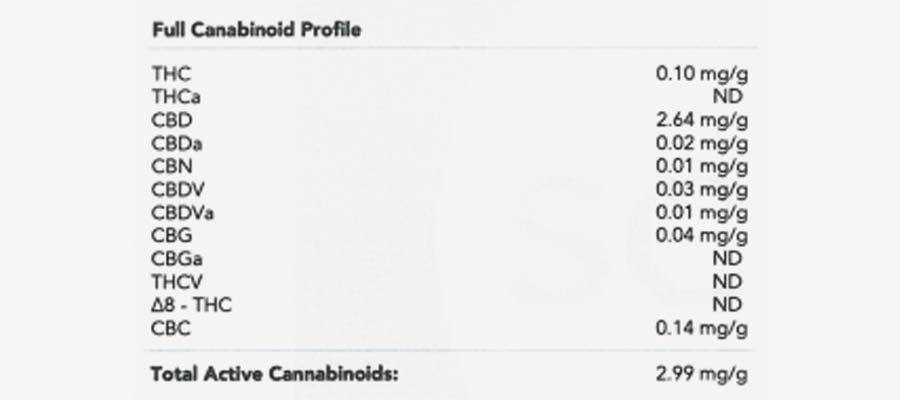
A CoA might identify dozens of cannabinoids in a CBD product – especially for full-spectrum products. You’ve heard of CBD, THC, and CBG, among other cannabinoids. However, the cannabis plant contains hundreds of lesser-known cannabinoids as well. A lab report identifies the most concentration cannabinoids in the formula.
Other cannabinoids may be linked to their health effects. However, most people are interested in the best-known and best-researched cannabinoids, including:
THC: Tetrahydrocannabinol (THC) is a cannabinoid in the cannabis plant associated with psychoactive properties. It’s the natural chemical that gets you high. CBD products contain less than 0.3% THC content by law. Most contain much less than that amount. If a CBD product contains more than 0.3% THC, it’s considered marijuana, which is federally illegal in the United States. If it contains less than 0.3% THC, then it’s considered hemp, which is legal in all 50 states.
CBD: Cannabidiol (CBD) is another well-known cannabinoid in the cannabis plant. CBD is linked with various benefits, from anti-seizure effects to anti-anxiety. If you’re looking at the CoA for a CBD product, then pay attention to the CBD content.
CBG: Cannabigerol isn’t as well-known as the two compounds above, although it’s associated with its health effects. CBG is an analgesic, anti-inflammatory, anti-bacterial, and anti-parasitic compound.
CBC: Cannabichromene (CBC) appears to work similarly to CBG. It has analgesic, anti-inflammatory, anti-bacterial, anti-fungal, and possibly even anti-depressant properties.
CBN: Cannabinol is the cannabinoid created when THC ages. Certain strains of cannabis (and certain CBD products) are rich with CBN.
LoD, LoB, and LoQ
At the of the table on the certificate, you’ll see three abbreviations, including a limit of detection (LoD), limit of quantitation (LoQ), and limit of blank (LoB). These terms describe the smallest amount of a substance that can be measured on the test.
LoD, LoB, and LoQ seem like similar terms – and they are. However, there are specific differences between the three:
Limit of Detection (LoD): Limit of detection is determined using the measured LoB and test replicates of a sample known to accommodate a low concentration of an analyte.
Limit of Quantitation (LoQ): Limit of quantitation is the lowest concentration that can be identified in the tested substance.
Limit of Blank (LoB): Limit of blank is the highest recorded analyte concentration one can expect to locate when testing replicates of a blank sample.
You don’t have to memorize these terms to read a certificate of analysis for a CBD product. All of these terms generally refer to ‘the smallest amount of a substance the test can detect.’ Some certificates of analysis list this information, while others do not.
Microbes
Labs test CBD products for microbes. Common microbes on CBD products include salmonella, yeast, and molds. Plants naturally have different germs and bacteria, but your CBD should not have significant amounts of microbes.
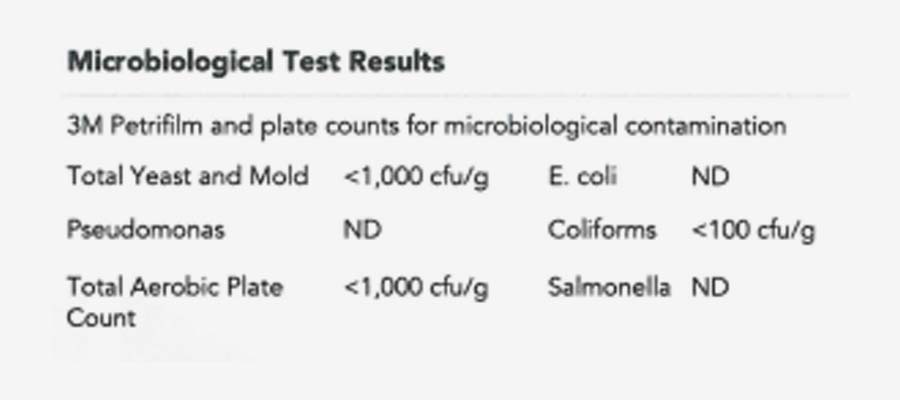
Generally, you want CBD products to contain few microbes. However, microbe content is particularly important for those with compromised immune systems. Someone with a healthy immune system can fight off small amounts of salmonella, yeast, and molds. Someone with a weak immune system, however, cannot tolerate any contamination. Some medical conditions prohibit you from consuming any amount of microbes – even levels that are safe for other people.
Whether you have a compromised immune system or not, it’s vital to check microbe content on your CBD product’s certificate of analysis.
ND (None Detected): Look for an ‘ND’ label in the microbe section. ND refers to none detected. The test also lists microbes in CFU/g, or colony-forming units per gram.
A certificate of analysis must disclose unsafe levels of microbes if detected. However, you would not likely see a hazardous rating on a certificate of study because it would not be allowed on the market.
Residual Solvents & Heavy Metals
To isolate CBD and other compounds, manufacturers use solvents. Sometimes, residual traces of these solvents end up in the finished product. That’s why some CBD products contain trace amounts of methyl.
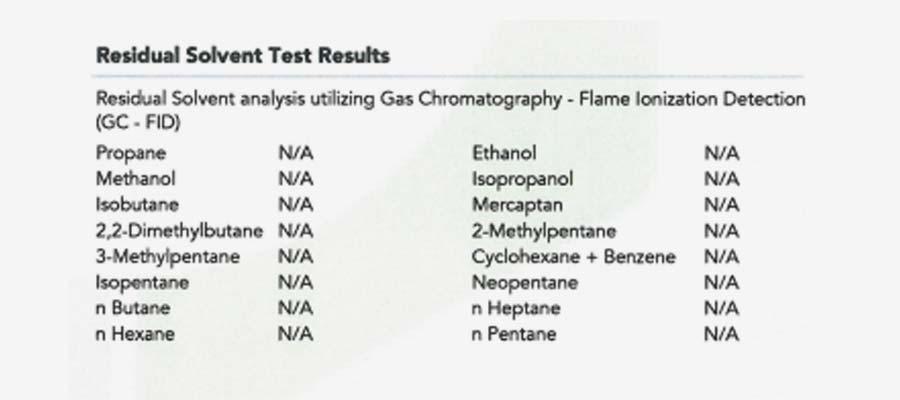
Other CBD products contain heavy metals. These heavy metals leaked from manufacturing equipment into the finished product. Even a trace amount of heavy metal in the cultivation or processing phase can add up to a significant amount of heavy metal in the finished product.
Check the certificate of analysis for any heavy metal content. Heavy metals like mercury and lead can be very harmful to your health. You want to see ‘ND’ (not detected) for all heavy metals, including arsenic, cadmium, mercury, and lead.
Like with microbes, you’ll see ‘PASS’ besides all heavy metal results. If a CBD product failed its heavy metal test, it would not be allowed on the market.
The test also mentions ‘MDL’, which is the lower limit of detection for the lab instruments (in micrograms per kilogram).
Under the ‘Use Limits’ section, look for ‘Ingestion’. This is the amount of the substance determined by health authorities to be harmful. Ingesting 1500 micrograms of arsenic per kilogram is known to be harmful, for example, which is why it’s important your CBD has an ‘ND’ rating for arsenic.
If the certificate of analysis lists a number instead of ‘ND’, it means traces of that heavy metal were found in the product. If there’s a ‘9’ beside mercury, for example, it means that 9 micrograms per kilogram of mercury were found in the tested substance. Any amount of mercury is bad, but you can verify that this amount is much lower than the ingestion limit from health authorities (1,500 micrograms per kilogram for mercury).
Pesticides
Growers use pesticides to protect their plants. Pesticides are unavoidable. However, you should still check the certificate of analysis for any information about pesticides – including whether levels of pesticide exceed the expected amount.
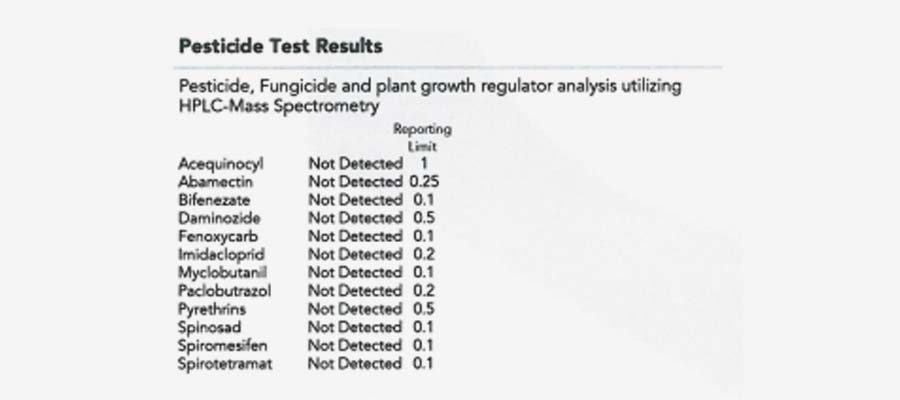
If growers use harmful pesticides, fungicides, and herbicides in or around their hemp cultivation, then your CBD oil could have residual chemicals inside. You don’t want these chemicals in your body.
Each certificate of analysis contains a ‘Pesticide Analysis’. This section of the report lists common pesticides used by growers, including how much of each pesticide was found in the tested product.
For pesticides, labs use ‘ppb’ or ‘parts per billion’ as a measurement unit. This section also lists a ‘lower limit of detection’ for each pesticide, which is the lowest amount of the pesticide that can be detected.
The ‘Limits’ column is the maximum amount of the pesticide you can consume based on government safety standards. This amount varies depending on your government authority.
The most important thing to check in the pesticide section is the last column: Status. If the CBD product had lower than the acceptable amount of pesticide, then the product gets a ‘PASS’. If the product exceeded the amount of a pesticide, then it gets a ‘NO PASS’. In most certificates of analysis, you’ll see a ‘PASS’ for all pesticides – although you should check the numbers to verify any unusually high amounts.
Terpenes
Many CBD users want high levels of terpenes. Terpenes are found in full-spectrum CBD products. Growing research links terpenes to various benefits. Some studies show terpenes have an ‘entourage effect’. They enhance the benefits of CBD.
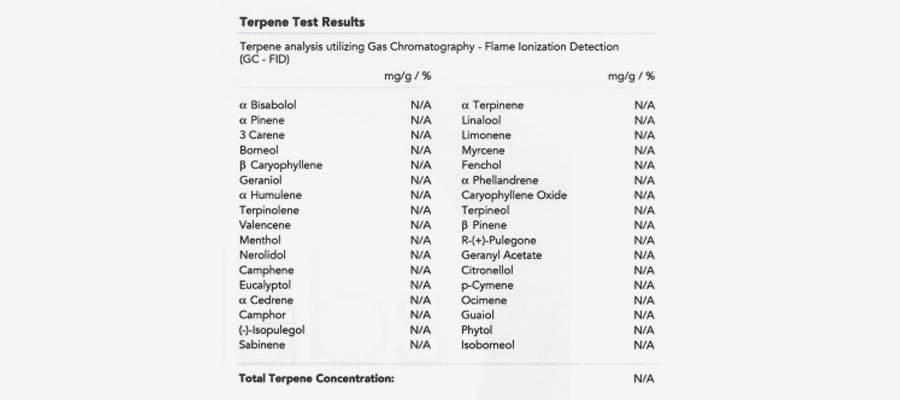
Even if you don’t believe in the benefits of terpenes, terpenes contribute to the taste and aroma of the plant. The certificate of analysis lists terpenes that can give you an idea of the taste and aroma of the plant.
Look for the ‘Terpenes Profile’ part of the certificate of analysis. This section of the test shows which terpenes were detected in the sample, including the relative amount of each terpene by weight percent. You can view specific terpenes like terpineol, B-pinene, B-caryophyllene, and menthol, among others.
If you believe in the benefits of terpenes or the ‘entourage effect’, then check the terpene section of the lab report.
You should also check the terpene section if you purchased a full-spectrum CBD product. Check the terpene profile to verify the presence of terpenes. Or, if you purchased a CBD isolate and want to verify there are no other terpenes or cannabinoids, then check the terpene test results.
Supplements & Additives
Some CBD products contain additional supplements, ingredients, or additives. Some companies mix CBD with turmeric, for example, to enhance anti-inflammatory effects.
Generally, these additives do not appear on a certificate of analysis. The lab is testing the CBD itself – not the overall supplement.
However, the certificate analysis may mention coconut oil, hemp oil, and other base oils – especially if testing a liquid CBD product. Pay attention to these base oils if you’re allergic to any compounds or sensitive to certain additives.
Top 6 Warnings Signs on a Certificate of Analysis
Certificates of analysis can separate good and bad CBD products – if you know where to look. Here are 6 CBD CoA red flags that show you shouldn’t buy a product:
Accurate CBD Content: Good CBD products are rich with CBD. A certificate of analysis confirms the advertised amount of CBD, showing the product has the exact amount labeled on the packaging. Pay close attention to the CBD dosage on the CoA. We’ve spotted manufacturers advertising high dosages, only to publish CoAs with half that dosage. They assume people don’t know how to read the CoA – but we do.
High THC Content: CBD products cannot contain more than 0.3% THC. If the product has more than 0.3% THC, then it’s considered marijuana and may be illegal. Some CBD products specifically claim to have 0.0% THC (to avoid marking up a drug test), so check the CoA to make sure. Overall, the CoA needs to confirm the advertised CBD and THC content.
Short List of Cannabinoids: A certificate of analysis lists 10+ cannabinoids. You should be wary of a CoA that only lists CBD and THC. Most cannabis products contain at least trace amounts of CBDa, CBG, CBN, CBC, and dozens of other cannabinoids.
No Lab Information: A good certificate of analysis transparently lists lab information, including contact details for the lab. Bad CoAs do not list lab contact information. Or worse: the lab and manufacturer have the same address, suggesting the test was performed in-house (and not at an independent lab).
Outdated Tests: Check the date of the CoA. A manufacturer might have requested one test back in 2014, for example, and has used that test for years.
No CoA: Perhaps the biggest red flag on a CoA is the lack of a certificate entirely. Bad CBD manufacturers refuse to test their products – or refuse to release CoAs. If a manufacturer is not transparent with its certificate of analysis, you should find a better CBD product.
Verifying Organic Status with a Certificate of Analysis
Many CBD products claim to be organic – yet they’re not actually organic. It’s difficult for CBD companies to get organic certification (say, through the USDA or other governing bodies). That means manufacturers can toss around labels like “organic” and “natural”.
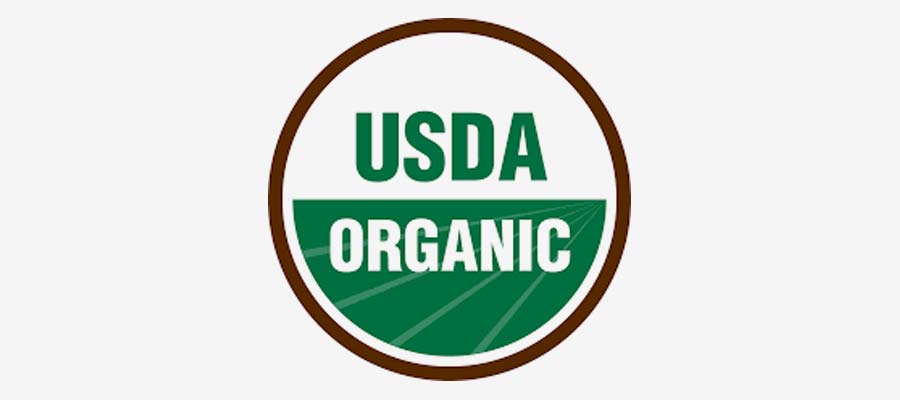
Even the best CBD companies are not fully organic, and few are USDA Organic certified (although many are in the process of becoming certified). Because of the lack of regulation, organic certification in the CBD space can be messy.
Generally, agricultural products are considered organic if they meet the following standards:
- Modest cropping effect on local ecosystems
- Low pollution or contamination risk during manufacturing, use, or disposal
- Grown with sustainable farming practices
There are different types of organic labels. Some foods claim to be 100% organic, for example, while others simply claim to be organic:
- 100% Organic: All ingredients and practices used to make the CBD product are certified as natural.
- Organic: Most (over 95%) of the ingredients and practices used to make the CBD product are certified as natural, although there may be some chemical additives.
- Natural or Made with Natural Ingredients: Only some components within the product are organic.
What Makes CBD Organic?
Cannabis or hemp growers must follow certain protocols for their products to qualify as organic.
Medical physicist Anastasiia Myronenko recommends growers meet five certifications to qualify as organic:
Untouched hemp seeds with no chemical components or modified ingredients. Plant seeds must be pure to qualify for organic status. Growers cannot use feminized seeds (or any type of modification) when growing organic crops.
Natural fertilizer. Hemp plants can achieve organic certification if grown in the right soil. Soil must be fertilized naturally. That means no chemical fertilizer. Soil must be 100% natural from the start to end of the growing process.
No growth enhancers. Growing plants is hard. Some growers cheat the system, using artificial growth stimulators for higher yields. The industry has all types of growth enhancers, stimulators, and hormones, among other stimulators. Growth stimulators can change the chemical composition of the plant. They can also impact human hormones.
Overall plant health. Healthy hemp plants are free of bacteria and parasites. They grow strong without the use of artificial stimulants. They’re free of disease, and farmers don’t have to resort to pesticides or other interventions. To protect plant health, farmers can use interventions like sprays and soil treatment. However, to qualify as organic, farmers must use these interventions sparingly. There’s an ongoing debate about how much chemical pesticide to use – and what amount is acceptable for organic status.
Lack of radiation. Organic crop farmers focus on beta radiation. Plants can absorb beta radiation. If this radiation enters the human body, it can cause severe damage. If a hemp plant contains beta radiation, then it does not qualify as organic. Radiation can appear when growers use radioactive isomers in their manufacturing facilities, contaminating local soil and water supply.
Organic certification continues to be a challenge for the CBD industry. Even the top growers struggle to meet organic certification standards.
Charlotte’s Web, for example, is one of the highest-quality CBD oil manufacturers available today. The company claims approximately 50% of its cultivation fields are “in the process of being certified organic by USDA recognized agencies”.
Final Word on Analyzing CBD Oil CoA Tests
Certificates of analysis play a crucial role in the CBD space. Certificates of analysis make it easy to compare CBD products.
Certificates of analysis seem intimidating – but they’re less complicated than you think.
If you’re careful about choosing your CBD, then take a few minutes reading certificates of analysis. Any company can make big claims with its marketing – but only the best companies back it up with strong certificates of analysis.



